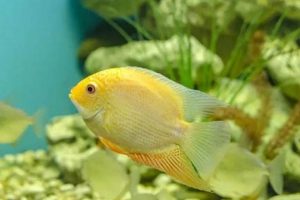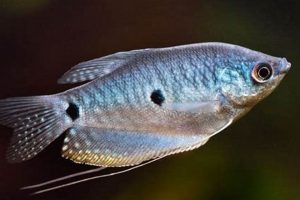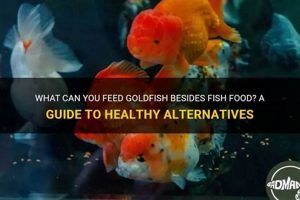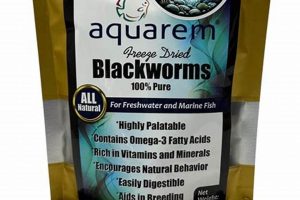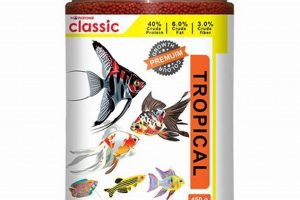The dietary requirements of the Northern Pike, a predatory freshwater fish, are primarily carnivorous. Their nutritional needs are met through a diet consisting predominantly of other fish. These piscivorous habits necessitate a diet rich in protein and fats to sustain their energy demands and rapid growth. The size and type of prey consumed varies depending on the pike’s age and habitat; younger pike consume smaller fish and invertebrates, while adults target larger fish species.
Optimal nutrition is crucial for the health, growth, and reproductive success of these apex predators within their ecosystems. A consistent and adequate food supply ensures the pike’s role in maintaining balance within the aquatic environment by controlling populations of other fish species. Historically, understanding the food preferences of pike has been vital for fisheries management and conservation efforts, impacting stocking strategies and habitat preservation.
The subsequent sections will delve into the specific types of prey consumed by pike, the impact of diet on their growth and survival, and strategies for providing suitable nourishment in both natural and controlled environments.
Pike Nutritional Strategies
Optimizing the diet of pike is critical for their growth, health, and survival, both in natural and managed environments. The following guidance provides essential considerations for ensuring adequate nutrition.
Tip 1: Prioritize Piscivorous Feeding: Pike are primarily piscivores. Ensure that their diet consists predominantly of fish. This aligns with their natural feeding behavior and provides the necessary protein and fats for optimal growth.
Tip 2: Match Prey Size to Pike Size: Offer prey fish that are appropriately sized for the pike’s gape. Smaller pike require smaller prey, while larger pike can consume larger fish. Offering appropriately sized prey minimizes the risk of feeding difficulties and ensures efficient energy intake.
Tip 3: Vary the Prey Species: Provide a diverse range of prey fish species. This ensures a balanced intake of essential nutrients and minimizes the risk of nutritional deficiencies associated with a monotonous diet. Variety also mimics the natural feeding patterns of pike in diverse aquatic ecosystems.
Tip 4: Monitor Growth Rate: Regularly assess the growth rate of pike to determine if their dietary intake is sufficient. A slow growth rate may indicate inadequate nutrition, prompting adjustments to the type, size, or quantity of food provided.
Tip 5: Consider Environmental Factors: Water temperature, oxygen levels, and habitat complexity can influence the pike’s feeding behavior and metabolic rate. Adjust the food supply based on these environmental factors to ensure optimal nutrient absorption and energy expenditure.
Tip 6: Implement Supplemental Feeding (in Controlled Environments): In aquaculture or managed environments, supplemental feeding with formulated diets can be beneficial. However, these diets should be carefully formulated to mimic the nutritional composition of natural prey and should be used to complement, not replace, live or frozen fish.
Tip 7: Observe Feeding Behavior: Closely monitor the pike’s feeding behavior. Reduced appetite or difficulty consuming prey may indicate underlying health issues or suboptimal environmental conditions. Addressing these issues promptly is critical for maintaining the pike’s overall health and nutritional status.
By carefully considering these nutritional strategies, it is possible to improve the health and growth outcomes of pike populations. Proper attention to nutritional needs can positively impact pike population dynamics and the health of the aquatic ecosystem.
The upcoming sections will provide further insights into specific strategies for optimizing the nourishment of pike within diverse ecological contexts.
1. Prey Species
The composition of “pike fish food” is intrinsically linked to available prey species within their aquatic habitat. The Northern Pike, being an apex predator, primarily sustains itself through piscivory, making the availability and health of various fish species a direct determinant of its nutritional well-being. A diverse and abundant prey base ensures a balanced diet, providing essential proteins, fats, and micronutrients vital for growth, reproduction, and overall health. For example, in regions where forage fish like perch, roach, or other cyprinids are plentiful, pike populations tend to thrive. Conversely, declines in these prey species due to overfishing, habitat degradation, or invasive species can lead to nutritional stress, reduced growth rates, and population declines in pike.
The connection extends beyond mere availability. The specific nutritional profile of each prey species contributes uniquely to the “pike fish food” composition. For instance, fatty fish like smelt or alewives provide higher energy content, crucial for pike during periods of high activity or spawning. Understanding these specific dietary contributions is essential for fisheries managers aiming to optimize pike populations. In situations where natural prey is limited, strategic stocking of suitable alternative prey species can serve as a valuable management tool. Alternatively, rehabilitation of existing prey populations through habitat restoration efforts may alleviate dietary constraints impacting pike health.
Ultimately, the health and abundance of prey species directly dictates the quality and quantity of “pike fish food,” which determines the success or failure of pike populations. Monitoring and managing prey species becomes a fundamental aspect of any comprehensive pike management plan. Failure to recognize and address the link between prey availability and pike nutrition can undermine conservation efforts and negatively impact the ecological balance of aquatic ecosystems.
2. Size requirements
The size of prey, a critical element in the context of “pike fish food”, directly impacts the feeding efficiency, energy intake, and overall survival of Northern Pike. The relationship between predator and prey size is governed by physical limitations and energetic demands, influencing the pike’s growth, health, and population dynamics.
- Gape Limitation and Prey Size Selection
A pike’s gape, or the maximum opening of its mouth, imposes a physical constraint on the size of prey it can successfully capture and consume. Pike typically target prey that can be swallowed whole or in manageable pieces. Attempting to consume prey that exceeds this gape limitation can result in injury, energy expenditure without successful ingestion, and potential starvation. Juvenile pike, with smaller gapes, rely on smaller invertebrates and fish larvae, while larger adults can consume substantially larger fish. Understanding gape limitation is crucial for managing pike populations, particularly in stocking or aquaculture scenarios.
- Energetic Efficiency and Optimal Prey Size
The energetic cost of capturing and consuming prey is a critical consideration. While larger prey offers a higher caloric reward, it may also require greater energy expenditure to subdue and ingest. The optimal prey size represents a balance between energy gain and energy cost. Pike tend to select prey that provides the maximum net energy gain, which can vary depending on factors such as prey abundance, swimming speed, and evasive maneuvers. Prey that are too small may not provide sufficient calories to offset the energy expended in capture, while prey that are too large may be difficult or impossible to handle. This energetic efficiency consideration drives pike foraging behavior and influences the composition of their diet.
- Ontogenetic Shifts in Prey Size
As pike grow and mature, their prey size preferences shift. This ontogenetic shift reflects changes in gape limitation, swimming ability, and energy requirements. Young-of-the-year pike rely on small invertebrates, transitioning to small fish as they grow. Adult pike can consume significantly larger fish, including other pike (cannibalism). Understanding these ontogenetic shifts is essential for managing pike populations across different life stages and ensuring an adequate food supply for all size classes. Stocking programs, for instance, must consider the available prey base and size structure to avoid competition or predation of smaller pike by larger individuals.
- Environmental Factors Influencing Prey Size Availability
Environmental conditions can indirectly impact the availability of appropriately sized prey. Habitat degradation, pollution, or invasive species can alter the size structure of prey populations, limiting the availability of suitable food for pike. For example, if invasive species outcompete native forage fish, the availability of appropriately sized prey may decline, leading to nutritional stress and reduced growth rates in pike. Similarly, changes in water temperature or oxygen levels can affect the distribution and abundance of prey species, further influencing the availability of appropriately sized food. Habitat restoration and management practices that promote healthy and diverse prey populations are crucial for ensuring a sustainable food supply for pike.
The relationship between size requirements and “pike fish food” underscores the importance of considering both the physical limitations of the predator and the ecological context of its environment. Management strategies that focus on maintaining healthy prey populations of appropriate sizes are essential for supporting healthy and sustainable pike populations.
3. Nutritional content
The nutritional content of “pike fish food” is a fundamental determinant of pike health, growth rate, reproductive success, and overall fitness. The specific nutrients derived from prey species directly influence the physiological processes and ecological role of this apex predator.
- Protein Composition and Muscle Development
Protein constitutes a primary building block for muscle tissue and is essential for the rapid growth characteristic of pike. Prey fish with high protein content, such as perch or roach, support efficient muscle development, enhancing swimming performance and predatory capabilities. Deficiencies in dietary protein can lead to stunted growth, reduced muscle mass, and impaired ability to capture prey. The amino acid profile within the protein source is also crucial, as pike require specific essential amino acids that they cannot synthesize themselves. Therefore, the quality and quantity of protein in “pike fish food” directly impact the pike’s ability to thrive.
- Lipid Content and Energy Storage
Lipids, or fats, serve as a concentrated source of energy for pike, particularly during periods of high activity, such as spawning or migration. Fatty fish species like smelt or alewives provide a rich source of lipids, which are stored as energy reserves. These reserves support metabolic functions, enhance buoyancy, and contribute to the development of reproductive tissues. Deficiencies in dietary lipids can lead to reduced energy reserves, impaired reproductive capacity, and increased susceptibility to disease. The types of fatty acids present (e.g., omega-3 and omega-6) also play a role in immune function and overall health. Thus, an adequate supply of lipids in “pike fish food” is crucial for pike to maintain energy balance and thrive in their environment.
- Micronutrient Availability and Physiological Function
Micronutrients, including vitamins and minerals, are essential for various physiological functions in pike, such as immune system regulation, bone development, and enzyme activity. Prey fish with diverse diets and varied habitats provide a range of micronutrients. For example, vitamin A is crucial for vision, while vitamin D is essential for calcium absorption and bone mineralization. Minerals like zinc and selenium play roles in antioxidant defense and enzyme function. Deficiencies in specific micronutrients can lead to compromised immune function, skeletal deformities, and impaired physiological processes. The availability of these micronutrients in “pike fish food” is, therefore, critical for maintaining pike health and resilience.
- Digestibility and Nutrient Absorption
The digestibility of “pike fish food” influences the efficiency with which pike can extract nutrients from their prey. Factors such as prey size, skeletal composition, and the presence of indigestible components (e.g., exoskeletons of invertebrates) affect digestibility. High digestibility ensures that pike can efficiently absorb essential nutrients, minimizing energy expenditure on digestion. Conversely, prey that is difficult to digest may result in reduced nutrient absorption and increased energy expenditure. The state of the pike’s digestive system also influences digestibility; healthy pike with functional digestive enzymes will extract nutrients more efficiently. The digestibility of “pike fish food” is, therefore, a crucial consideration in optimizing pike nutrition and growth.
In conclusion, the nutritional content of “pike fish food” is a complex interplay of protein, lipids, micronutrients, and digestibility, all of which directly impact the health, growth, and survival of pike. Understanding these nutritional dynamics is crucial for effective management and conservation of pike populations. Manipulating prey availability to optimize the nutritional content available to pike is a key element in maintaining healthy and sustainable aquatic ecosystems.
4. Availability
The availability of suitable “pike fish food” constitutes a fundamental limiting factor for pike populations, influencing their distribution, abundance, and overall health. The accessibility of prey in terms of location, quantity, and timing directly shapes the nutritional landscape for pike, dictating their survival and reproductive success.
- Habitat Accessibility and Prey Distribution
Pike rely on habitats that provide sufficient cover for ambush predation and proximity to prey populations. Habitat fragmentation, degradation, or alteration can restrict pike access to prey-rich areas, limiting food availability. For instance, dam construction can block pike migration routes to spawning grounds, disrupting access to crucial feeding habitats. Similarly, the removal of aquatic vegetation reduces ambush opportunities, decreasing hunting success. Therefore, the physical accessibility of habitats that support prey populations is a critical determinant of pike food availability.
- Seasonal Fluctuations in Prey Abundance
Prey availability often fluctuates seasonally, impacting pike foraging success and energy reserves. During periods of high prey abundance, such as spring spawning runs of forage fish, pike can efficiently accumulate energy stores. Conversely, during periods of low prey abundance, such as winter months or after spawning, pike may experience nutritional stress. These seasonal fluctuations can influence growth rates, reproductive output, and overwinter survival. Understanding these temporal patterns is essential for managing pike populations and predicting their response to environmental changes.
- Interspecific Competition and Prey Partitioning
Pike often coexist with other predatory fish species, leading to interspecific competition for available prey resources. The degree of competition depends on the overlap in diet, habitat use, and foraging strategies. In environments with high competition, pike may experience reduced access to preferred prey, leading to dietary shifts or reduced growth rates. The presence of invasive species can further exacerbate competition, altering the composition and availability of prey populations. Understanding the interactions between pike and other predators is crucial for managing fish communities and maintaining a sustainable food supply for pike.
- Water Quality and Prey Health
Water quality parameters, such as temperature, oxygen levels, and nutrient concentrations, can influence the health and abundance of prey populations. Poor water quality can stress or kill prey fish, reducing their availability to pike. For example, eutrophication can lead to algal blooms that deplete oxygen levels, creating dead zones that limit prey distribution. Pollution from agricultural runoff or industrial discharge can also negatively impact prey health and survival. Maintaining good water quality is, therefore, essential for supporting healthy prey populations and ensuring a sustainable food supply for pike.
The multifaceted nature of “availability” as it pertains to “pike fish food” highlights the interconnectedness of habitat quality, prey dynamics, and water quality in determining pike population health. Management strategies aimed at conserving pike populations must consider these factors holistically, promoting habitat restoration, controlling invasive species, and maintaining good water quality to ensure a consistent and accessible food supply.
5. Environmental impact
The ecological consequences of “pike fish food” acquisition and consumption are multifaceted, extending beyond simple predator-prey relationships. The presence and actions of pike influence community structure, nutrient cycling, and overall ecosystem health. Specifically, the selection of prey species by pike can trigger trophic cascades, where the reduction of certain forage fish populations results in increased abundance of their invertebrate prey, ultimately altering primary producer communities. For example, intense predation on planktivorous fish may lead to increased algal blooms due to decreased grazing pressure from zooplankton. The magnitude of these effects is dependent on the pike population density, habitat complexity, and the resilience of the prey community.
The introduction of non-native prey species as “pike fish food” can further exacerbate environmental impacts. The unintentional or intentional introduction of species such as common carp into pike habitats can lead to significant alterations in water quality, vegetation density, and overall habitat suitability for native fish. Pike may readily consume these introduced species, indirectly contributing to their proliferation and the associated ecological damage. Furthermore, the accumulation of pollutants, such as mercury or PCBs, in “pike fish food” can biomagnify through the food web, reaching high concentrations in pike tissues, with potential consequences for their health and the health of any predators that consume pike, including humans. The source and fate of these contaminants within the aquatic ecosystem warrants careful monitoring.
The management of “pike fish food” resources necessitates a holistic approach that considers the broader environmental context. Maintaining healthy and diverse prey populations is critical for ensuring the long-term sustainability of pike populations, while also mitigating potential ecological disruptions. Restoration of degraded habitats, control of invasive species, and implementation of responsible fishing practices are essential components of this strategy. Understanding the intricate connections between “pike fish food” and the wider ecosystem is paramount for effective conservation and management efforts.
6. Management strategies
Effective management strategies are inextricably linked to the availability and quality of “pike fish food.” These strategies directly impact the health, abundance, and sustainability of pike populations by influencing the food web dynamics within their aquatic habitats. The selection and implementation of appropriate management actions, therefore, hinges on a comprehensive understanding of the dietary needs of pike and the factors that affect prey availability. For example, habitat restoration projects that focus on enhancing spawning grounds for forage fish directly contribute to increased “pike fish food” resources. Similarly, regulations limiting the harvest of key prey species ensure that pike have an adequate food supply, supporting their growth and reproductive success. Failure to consider “pike fish food” in management decisions can lead to unintended consequences, such as population declines or shifts in community structure.
Practical applications of this understanding are numerous. Fisheries managers routinely monitor the abundance and size structure of prey populations to assess the nutritional status of pike and identify potential food limitations. Stocking programs can be designed to introduce suitable prey species into areas where “pike fish food” is scarce, providing a supplemental food source and improving pike growth rates. Furthermore, regulations governing water quality and habitat protection are essential for maintaining healthy prey populations. The establishment of protected areas, where fishing pressure is restricted, can also serve to safeguard “pike fish food” resources. An example is the implementation of catch-and-release regulations for certain forage fish species in areas known to support pike populations, ensuring that these prey fish remain available to sustain pike growth and reproduction. The effectiveness of these management strategies is often evaluated through monitoring pike condition, growth rates, and population size.
In summary, the management of “pike fish food” is a critical component of overall pike management. A focus on maintaining healthy and abundant prey populations is essential for ensuring the long-term sustainability of pike populations and the integrity of aquatic ecosystems. Challenges remain in balancing the needs of pike with other ecosystem objectives, such as recreational fishing and water resource management. Future research should focus on improving the understanding of pike diet dynamics and developing adaptive management strategies that can respond to changing environmental conditions.The ultimate success will depend on a collaborative approach involving fisheries managers, researchers, and stakeholders to protect and enhance “pike fish food” resources for the benefit of pike and the broader aquatic environment.
Frequently Asked Questions About Pike Fish Food
This section addresses common queries regarding the dietary needs of Northern Pike and the factors influencing their nutritional well-being.
Question 1: What constitutes the primary component of pike fish food in a natural environment?
The primary component consists of other fish species. Pike are obligate carnivores, primarily piscivorous, with their diet reflecting the available fish fauna within their habitat.
Question 2: How does the size of prey influence the nutritional intake of pike?
Prey size is critical. Pike have gape limitations, meaning they can only consume fish that fit within their mouth. The optimal prey size maximizes energy intake while minimizing the energy expenditure required for capture and consumption.
Question 3: What are the key nutritional elements required in pike fish food for optimal growth?
Protein and lipids are essential. Protein supports muscle development and growth, while lipids provide a concentrated source of energy, especially during periods of high activity or spawning. Micronutrients, such as vitamins and minerals, are also vital for various physiological processes.
Question 4: How does habitat degradation impact the availability of pike fish food?
Habitat degradation can reduce prey abundance and accessibility. Loss of aquatic vegetation, pollution, and habitat fragmentation can disrupt prey populations, limiting the food sources available to pike.
Question 5: Can the introduction of non-native species affect pike’s diet and the environment?
Yes, the introduction of non-native prey species can alter pike diets and trigger ecological imbalances. Introduced species may outcompete native prey, disrupt food web dynamics, and potentially introduce contaminants or diseases.
Question 6: What management strategies are effective in ensuring a sustainable supply of pike fish food?
Effective strategies include habitat restoration, regulation of fishing pressure on prey species, control of invasive species, and water quality management. These actions aim to maintain healthy and abundant prey populations, supporting the long-term sustainability of pike populations.
In summary, understanding the intricacies of pike fish food is essential for effective conservation and management. A focus on maintaining healthy and diverse prey populations is paramount for supporting the ecological role and vitality of Northern Pike.
The subsequent section will delve into the practical considerations for supplemental feeding programs where natural food sources are limited.
Conclusion
The preceding discussion has comprehensively addressed “pike fish food” from multiple angles, encompassing nutritional requirements, prey selection, environmental impact, and management strategies. It is established that a complex interplay of ecological factors governs the availability and suitability of prey for Northern Pike, directly influencing their health, growth, and population dynamics. The selection of appropriate management actions necessitates a thorough understanding of these factors, ensuring that conservation efforts are both effective and sustainable. A simplistic approach to manipulating food web dynamics or introducing non-native species can yield adverse consequences, underscoring the importance of holistic and informed decision-making.
The long-term health of pike populations rests on a commitment to responsible stewardship of aquatic ecosystems. Protecting and enhancing “pike fish food” resources requires sustained efforts to restore degraded habitats, manage invasive species, and mitigate pollution. Future investigations should focus on refining our understanding of pike diet dynamics and developing adaptive management strategies that can respond to evolving environmental conditions. Ultimately, the success of pike conservation hinges on the continued pursuit of scientific knowledge and the implementation of evidence-based management practices.


